Taxonomic Synopsis of Mascagnia (Malpighiaceae) of Brazil
Abstract
1. Introduction
2. Materials and Methods
3. Results
- Key to the species of Mascagnia from Brazil
- 1. Flowers/fruits grouped in corymbs (1st order inflorescences)............................................ 2
- 1. Flowers/fruits grouped in thyrses (1st order inflorescences)..……………………........... 13
- 2. Corymbs solitary (1st order inflorescences)........................................................................... 3
- 2. Corymbs grouped in thyrses or in pairs (2nd order inflorescences).................................. 8
- 3. Petals pink, lilac to reddish...................................................................................................... 4
- 3. Petals yellow.............................................................................................................................. 5
- 4. Liana, leaves petioles up to 10 mm long, margin plane, veins adaxially impressed, abaxially sparsely tomentose, petals pink to lilac………………………………........... M. affinis
- 4. Shrub, leaves petioles up to 3 mm long, margin revolute, veins adaxially bullate, abaxially densely whitish tomentose, petals pink to reddish………………….............. M. aptera
- 5. Leaves chartaceous, leaf blade wide-elliptic to obovate...…………………………........... 6
- 5. Leaves membrane or coriaceous, leaf blade ovate….………………………………........... 7
- 6. Leaf base obtuse to rounded, veins adaxially impressed, tomentose; bracteoles 0.6–0.8 mm long; flowers with pedicels up to 14 mm long………………………........... M. australis
- 6. Leaf base cordate, veins adaxially bullate, velutine; bracteoles 1.2–1.8 mm long; flowers with pedicels up to 7 mm long…..………………………………............................ M. velutina
- 7. Leaves coriaceous, conduplicate, apex acuminate, abaxially multiglandular, glabrous; peduncle + pedicel up to 14 mm long, bracteoles 2–2.4 mm long; mericarps up to 40 mm diam…………………………………………………………………………................ M. bierosa
- 7. Leaves membranous, plane, apex acute, abaxially 2-3-glandular, sparsely sericeous, peduncle + pedicel up to 9 mm long, bracteoles 0.7–1.1 mm long; mericarps up to 25 mm diam………………………………………………………………………...………….. M. sepium
- 8. Inflorescences born apically on branches…………………………………….. M. loretensis
- 8. Inflorescences born laterally on branches…………………………………………………... 9
- 9. Leaves tomentose or sericeous; thyrses of 2–5 corymbs (2nd order inflorescences)…. 10
- 9. Leaves glabrous; thyrses of 7–9 corymbs (2nd order inflorescences)…...…………….... 14
- 10. Leaves sericeous to glabrescent; thyrses of 3–5 corymbs…………………… M. arenicola
- 10. Leaves tomentose; thyrses of 2 corymbs…………………………………………………. 11
- 11. Vegetative leaves with margins plane; apex of styles uncinate, lateral stigmas drying blackish.……………………………………………………………………………….. M. riparia
- 11. Vegetative leaves with margin revolute; apex of styles truncate, lateral stigmas drying the same color as styles…………..………………………………………………..…………… 12
- 12. Leaves with veins adaxially bullate; corymbs grouped in thyrses, bracteoles inserted near apex of peduncles, bracteole gland as long as bracteoles; pedicel up to 3 mm long………………………………………………………...……………………... M. tucuruensis
- 12. Leaves with veins adaxially impressed; corymbs grouped in pairs, bracteoles inserted near the middle of peduncles, bracteole gland half the size of bracteoles; pedicel up to 8 mm long……………………………………………………………………….. M. cynanchifolia
- 13. Leaves associated with the inflorescence well-developed, lanceolate….............. M. lugoi
- 13. Leaves associated with the inflorescence very-reduced, elliptic to filiform…………………………………………………………………………….…... M. tenuifolia
- 14. Thyrses solitary (1st order inflorescences)…………………………………….................. 15
- 14. Thyrses arranged in thyrses (2nd order inflorescences)….……………………...……... 18
- 15. Petals yellow, mericarps with dorsal wing inconspicuous……………......... M. schunkei
- 15. Petals pink to lilac, mericarps with dorsal wing conspicuous……………………......... 16
- 16. Leaves orbicular, strigulose-tomentose, petals whitish lilac…………........ M. strigulosa
- 16. Leaves widely elliptic to ovate, sericeous to tomentose, petals pink……………......... 17
- 17. Leaves with base cordate, densely tomentose, bracteoles up to 2.5 mm long, Cerrado……………………………………………………………………………….... M. cordifolia
- 17. Leaves with base obtuse, sericeous to glabrate, bracteoles up to 1.5 mm long, Amazon…………………………………………………………….……......................... M. conformis
- 18. Leaves coriaceous, oblong, discolor…….……………………………........... M. dissimilis
- 18. Leaves chartaceous to membranous, ovate, concolor……………………………........... 19
- 19. Leaves with petioles up to 10 mm long, leaf blades up to 7 cm long, apex acute, mericarps up to 20 mm long………………………………………………………….. M. divaricata
- 19. Leaves with petioles up to 25 mm long, leaf blades up to 16 cm long, apex long-acuminate, mericarps up to 30 mm diam…………………………………………….. M. glabrata
- Mascagnia affinis W.R.Anderson & C.Davis, Contr. Univ. Michigan Herb. 24: 37–38. 2005. Type: BRAZIL. State of Mato Grosso: city of Porto Espiridião, MT265 road, km 60–70 of junction with BR174 road, 27 October 1995, fl., fr., Hatschbach 63949 (holotype: MBM barcode MBM374477!; isotypes: MICH barcode MICH1254374!, SPF barcode SPF179000!).
- 2.
- Mascagnia aptera W.R.Anderson, Contr. Univ. Michigan Herb. 14: 17. 1980. Type: BRAZIL. State of Mato Grosso: Chapada dos Guimarães, road from city of Buriti to city of Cuiaba, rocky escarpment, amongst sandstone rocks, 720 m alt, 22 October 1973, fl., fr., Prance et al. 19274 (holotype: INPA accession 42766!; isotypes: MICH barcode MICH1102233!, NY barcode NY00067647!, US barcode US00108443!).
- 3.
- Mascagnia arenicola C.E.Anderson, Brittonia 53: 406. 2001. Type: GUYANA. Pomeroon-Supenaam region: Mainstay Village, 10 m alt, 21 April 1989, fl., Gillespie 1086 (holotype: MICH barcode MICH1244745!; isotypes: US barcode US00588020!, U?). Figure 1.
- 4.
- Mascagnia australis C.E.Anderson, Brittonia 53: 408. 2001. Type: ARGENTINA. Department of Primero de Mayo: Colonia Benítez, Chaco, 14 December 1964, fl., Schulz 14299 (holotype: MICH barcode MICH1244744!; isotypes: CTES?, MO barcodes MO2230150!, MO2391252!). Figure 2.
- 5.
- Mascagnia bierosa (Moric. ex A.Juss.) W.R.Anderson, Contr. Univ. Michigan Herb. 25: 102, 104. 2007. Type: BRAZIL. State of Bahia: Blanchet s.n. (holotype: G barcode G00352843!). Figure 3.
- 6.
- Mascagnia conformis W.R.Anderson, Contr. Univ. Michigan Herb. 25: 104–105, 107. 2007. Type: BRAZIL. State of Pará: Santarém, road to Alter do Chão, Capoeira Baixa, sandy soil, 12 December 1978, fr., Vilhena et al. 251 (holotype: NY barcode NY1043201!; isotypes: MICH barcode MICH1244743!, NY barcode NY1043200!, U barcode U1367646!). Figure 4.
- 7.
- Mascagnia cordifolia (A.Juss.) Griseb., Fl. Bras. 12(1): 95. 1858. Type: Brazil. State of Minas Gerais: Curimataí, 1816–1821, fl., fr., Saint-Hilaire catal. B1, N1958 [lectotype designated by Anderson (1993): P barcode P02429202!; isolectotypes: MPU barcode MPU020180!, P barcodes P02429203!, P02429204!) Figure 6.
- 8.
- Mascagnia cynanchifolia Griseb., Fl. Bras. 12(1): 95. 1858. Type: BRAZIL. State of Amazonas: city of Manaus, near Barra, October 1851, fr., Spruce 1857 (lectotype designated here: K barcode K000427435!; isolectotypes: BM barcode BM000611537!, G barcodes G00352821! and G00352822!, GH barcode GH00254152!, GOET barcode GOET007639!, K barcode K000427436!, M barcode M0242686!, NY barcode NY00067651!, P barcodes P02429152! and P00689797!, TCD barcode TCD0003927!).
- 9.
- Mascagnia dissimilis C.V.Morton & Moldenke, Phytologia 1: 19. 1933. Type: COLOMBIA. Department of Boyacá: El Umbo region, 130 M-N of Bogota, forest’s edge, 3200 ft alt., 21 October 1932, fr., Lawrance 546 (holotype: NY barcode NY00067652!; isotypes: A barcode A00045141!, F barcode F0062742F!, G barcode G00352826!, MO barcode MO251783!, S accession S-R-9093!).
- 10.
- Mascagnia divaricata (Kunth) Nied., Nat. Pflanzenfam. 3(4): 55. 1896 [1890]. Type: VENEZUELA. Department of Sucre: Cumana, crescit in umbrosis, September, Bonpland and von Humboldt s.n. (holotype: P barcode P00679996!; isotypes: B†). Figure 7.
- 11.
- Mascagnia glabrata W.R.Anderson & C.Davis, Contr. Univ. Michigan Herb. 24: 43–44. 2005. Type: BRAZIL. State of Rondônia: Monte Negro, Taboca mining, 10 15S, 63 20W, capoeira, rocky soil, 11 October 1979, fl., fr., Vieira et al. 390 (holotype: INPA accession 88715!; isotypes: C barcode C10014233!, MICH barcode MICH1254372!, MO barcode MO-1515430!, NY barcode NY00743710!. Figure 8.
- 12.
- Mascagnia loretensis C.V.Morton, Proc. Biol. Soc. Washington 45: 49. 1932. Type: PERU. Department of Loreto: Mishuyacu, near Iquitos, 100 m alt., forest, February 1930, fl., Klug 907 (holotype: US barcode US00108451!; isotype: NY barcode NY00067660!).
- 13.
- Mascagnia lugoi W.R.Anderson, Contr. Univ. Michigan Herb. 21: 74–76. 1997. Type: ECUADOR. Department of Napo: Tierra Colorada, ca. 3 km N of Coca (Puerto Francisco de Orellana), 22 January 1973, fl., fr., Lugo 2920 (holotype: GB barcode GB0159593!; isotype: MICH barcode MICH1102241!).
- 14.
- Mascagnia riparia C.E.Anderson, Brittonia 53(3): 410. 2001. Type: BRAZIL. State of Rondônia: Jaci Paraná, 4 km above Jaci Paraná on Jaci Paraná River, terra firme flood forest, 28 Jun. 1968, fl., fr., Prance et al. 5289 (holotype: NY barcode NY01043508!; isotypes: INPA accession 22050!, K barcode K001227539!, MICH barcode MICH1244742!). Figure 9.
- 15.
- Mascagnia schunkei W.R.Anderson, Mem. New York Bot. Gard. 32: 222–224. 1981. Type: PERU. Department of Huánuco: Tingo Maria, east of Tingo Maria, 700 m alt., 24 October 1962. fl., fr., J. Schunke Vigo 6195 (holotype: F barcode F0092884F!; isotypes: LA?, US barcode US00108464!).
- 16.
- Mascagnia sepium (A.Juss.) Griseb., Fl. Bras. 12(1): 96. 1858. Type: BRAZIL. Rio de Janeiro: 1816–1821, fr., Saint-Hilaire Catal. C2 2º Partie no. 32 (lectotypes designated by Anderson 2007: P barcode P02429164!; isolectotypes: MPU barcode MPU020187!, P barcodes P02429165!, P02429166!, P02429167!, P02429168!, P02429169!). Figure 11.
- 17.
- Mascagnia strigulosa (Rusby) Nied., Pflanzenr. 141(Heft 91): 124. 1928. Type: BOLIVIA. Department of La Paz: Charopampa, 23 September 1901, fr., Williams 799 (lectotype designated by Anderson 2007: NY barcode NY00071323!; isolectotypes: BM barcode BM000611542!, K barcode K000427464!, MO barcodes MO1432410!, MO101837551!, MO101837552!, NY barcode NY00071324!, US barcode US00108498!). Figure 12.
- 18.
- Mascagnia tenuifolia Nied., Arbeiten Bot. Inst. Königl. Lyceums Hosianum Braunsberg 3: 10. 1908. Type: PERU. Department of Loreto: San Martín, near Tarapoto, 1855–1856, fl., fr., Spruce 4958 (lectotype designated by Anderson 2007: NY barcode NY00067678!; isolectotypes: BR barcode BR0000008696397!, G barcode G00352766!, GH barcode GH00254153!, GOET barcode GOET007647!, K barcodes K000202365!, K000202366!, MG barcode MG019499!, MO barcodes MO 102875380!, MO 102875381!, MO 102875382!, MO 102875383!, MO 100659090!, NY barcode NY00067677!, TCD barcode TCD0003923!).
- 19.
- Mascagnia tucuruensis C.E.Anderson, Brittonia 53(3): 413. 2001. Type: BRAZIL. State of Pará: Tucuruí, roadside outside airport, 10 February 1990, fl., W.R. Anderson 13749 (holotype: MICH barcode MICH1254371!). Figure 13.
- 20.
- Mascagnia velutina C.E.Anderson, Brittonia 53(3): 414. 2001. Type: BRAZIL. State of Minas Gerais: Carangola, São Martinho farm, 500 m alt., 6 October 1992, fl., fr. Leoni 1970 (holotype: MICH barcode MICH1244741!; isotypes: RB barcodes RB01189783!, RB01326315!). Figure 14
4. Discussion
Author Contributions
Funding
Data Availability Statement
Acknowledgments
Conflicts of Interest
References
- Anderson, W.R. Eight Segregates from the Neotropical Genus Mascagnia (Malpighiaceae). Novon J. Bot. Nomencl. 2006, 16, 168–204. [Google Scholar] [CrossRef]
- De Almeida, R.F.; De Morais, I.L.; Alves-Silva, T.; Antonio-Domingues, H.; Pellegrini, M.O.O. A New Classification System and Taxonomic Synopsis for Malpighiaceae (Malpighiales, Rosids) Based on Molecular Phylogenetics, Morphology, Palynology, and Chemistry. PhytoKeys 2024, 242, 69–138. [Google Scholar] [CrossRef] [PubMed]
- Royal Botanic Gardens Kew. Plants of the World Online. Available online: https://powo.science.kew.org/ (accessed on 15 May 2025).
- Almeida, R.F.D. Taxonomic Revision of Amorimia W.R. Anderson (Malpighiaceae). Hoehnea 2018, 45, 238–306. [Google Scholar] [CrossRef]
- Davis, C.C.; Anderson, W.R. A Complete Generic Phylogeny of Malpighiaceae Inferred from Nucleotide Sequence Data and Morphology. Am. J. Bot. 2010, 97, 2031–2048. [Google Scholar] [CrossRef] [PubMed]
- Anderson, W.R. Notes on Mascagnia in South America. Contr. Univ. Mich. Herb. 1980, 14, 17–23. [Google Scholar]
- Anderson, C. Novelties in Mascagnia (Malpighiaceae). Brittonia 2001, 53, 405–415. [Google Scholar] [CrossRef][Green Version]
- Anderson, W.R.; Davis, C.C. The Mascagnia cordifolia Group (Malpighiaceae). Contrib. Univ. Mich. Herb. 2005, 24, 33–44. [Google Scholar][Green Version]
- Thiers, B. Index Herbariorum. Available online: https://sweetgum.nybg.org/science/ih/ (accessed on 15 May 2025).[Green Version]
- Anderson, W.R. The Botany of the Guayana Highland Part XI Malpighiaceae; New York Botanical Garden: New York, NY, USA, 1981. [Google Scholar][Green Version]
- Radford, A.; Dickson, W.; Massey, J.; Bell, C. Vascular Plant Systematics; Harper and Row: New York, NY, USA, 1974. [Google Scholar][Green Version]
- Weberling, F. Typology of Inflorescences. J. Linn. Soc. Lond. Bot. 1965, 59, 215–221. [Google Scholar] [CrossRef]
- Spjut, R.W. A Systematic Treatment of Fruit Types; Engineering Bulletin; New York Botanical Garden: New York, NY, USA, 1994. [Google Scholar]
- Bachman, S.P.; Brown, M.J.M.; Leão, T.C.C.; Nic Lughadha, E.; Walker, B.E. Extinction Risk Predictions for the World’s Flowering Plants to Support Their Conservation. New Phytol. 2024, 242, 797–808. [Google Scholar] [CrossRef] [PubMed]
- ArcGIS, version 9.3.1; ESRI—Environmental Systems Research Institute: Redlands, CA, USA, 2010.
- WWF—World Wildlife Fund. Biomes. Available online: http://www.worldwildlife.org/biomes/ (accessed on 15 May 2025).
- Niedenzu, F. Das Pflanzenreich. Regni Vegetabilis Conspectus; Verlag von Wilhelm Engelmann: Leipzig, Germany, 1928. [Google Scholar]
- Anderson, W.R.; Davis, C.C. (2091) Proposal to Conserve the Name Mascagnia against Triopterys (Malpighiaceae). Taxon 2012, 61, 1124–1125. [Google Scholar] [CrossRef]
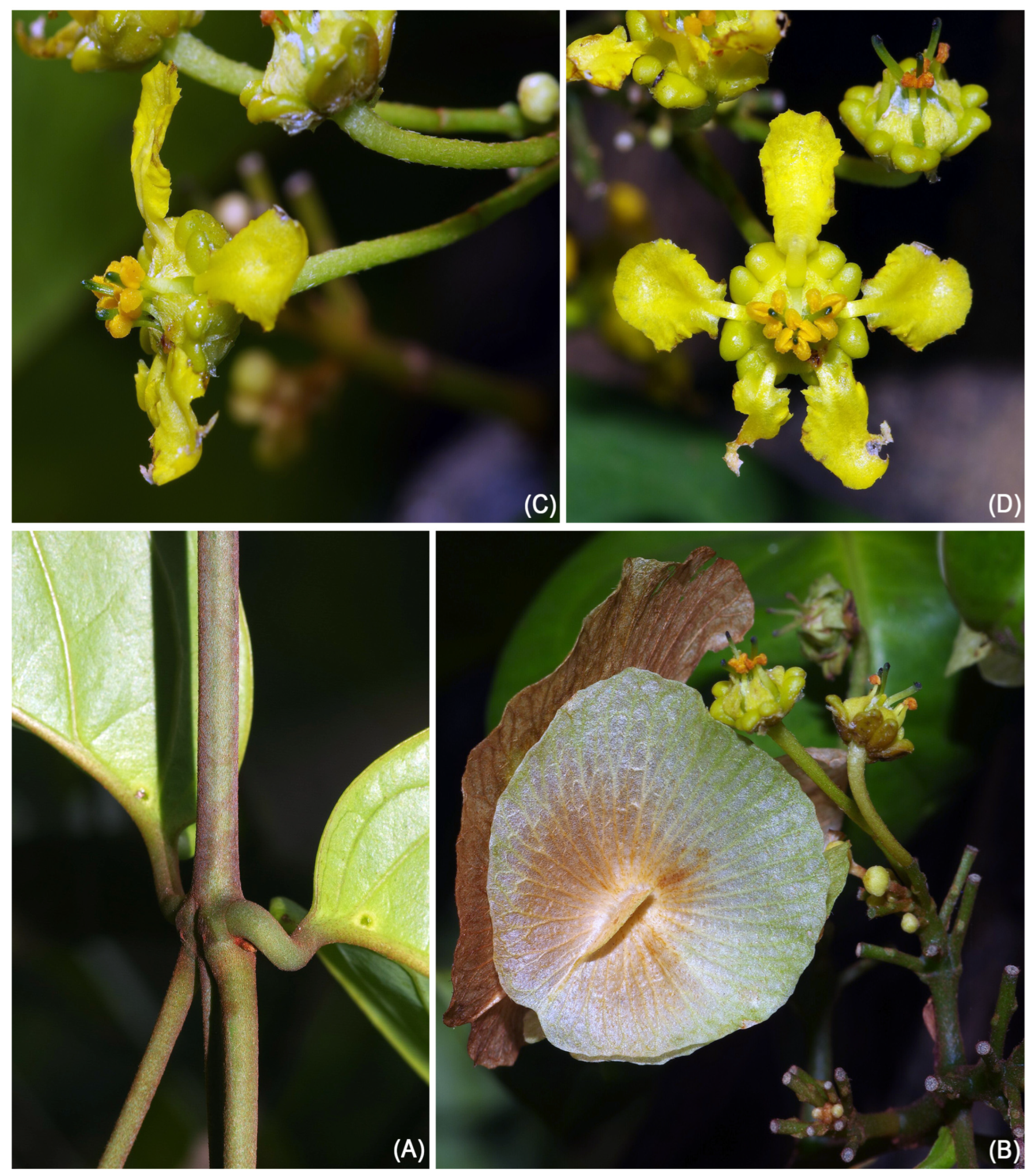

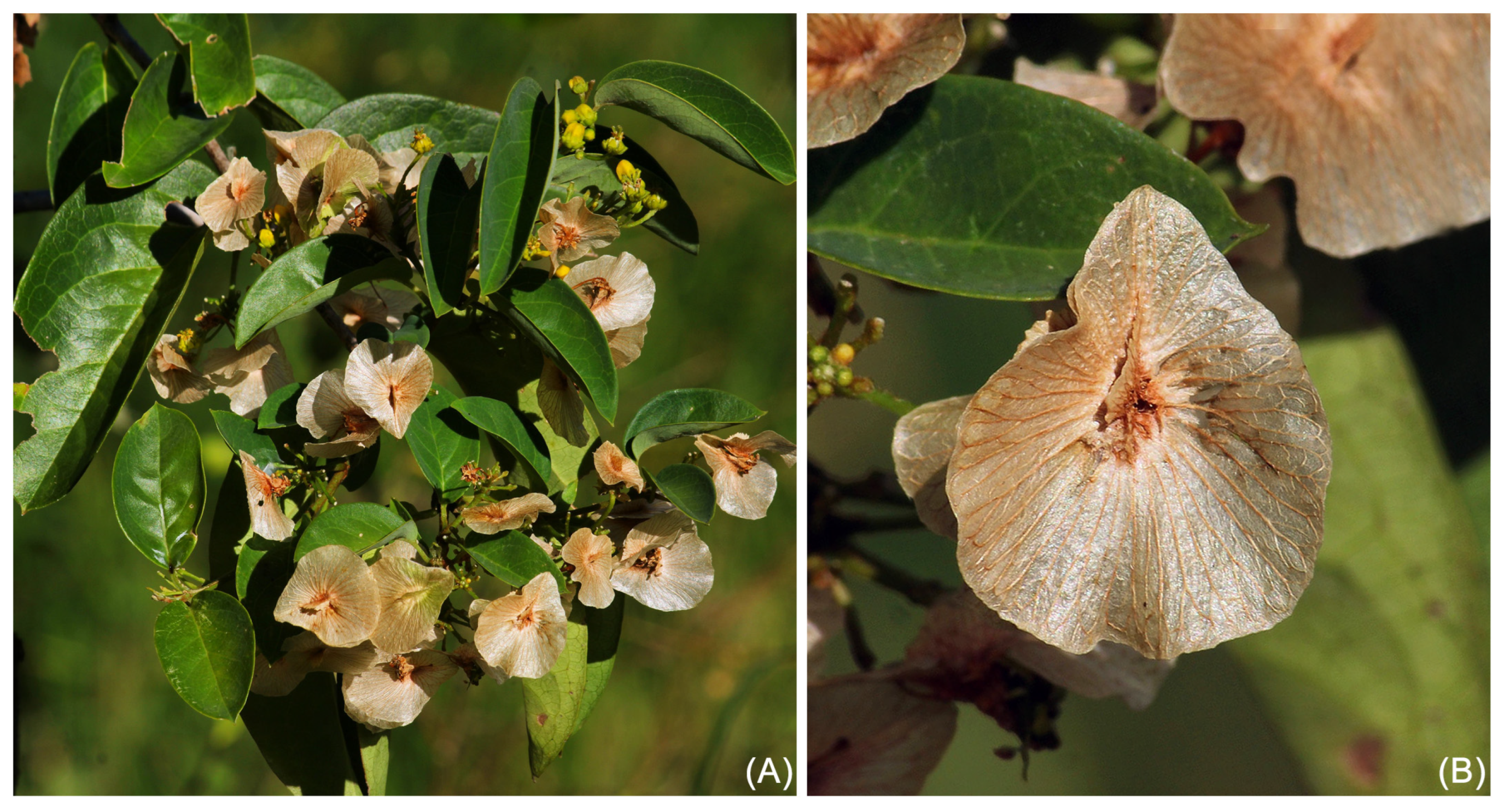
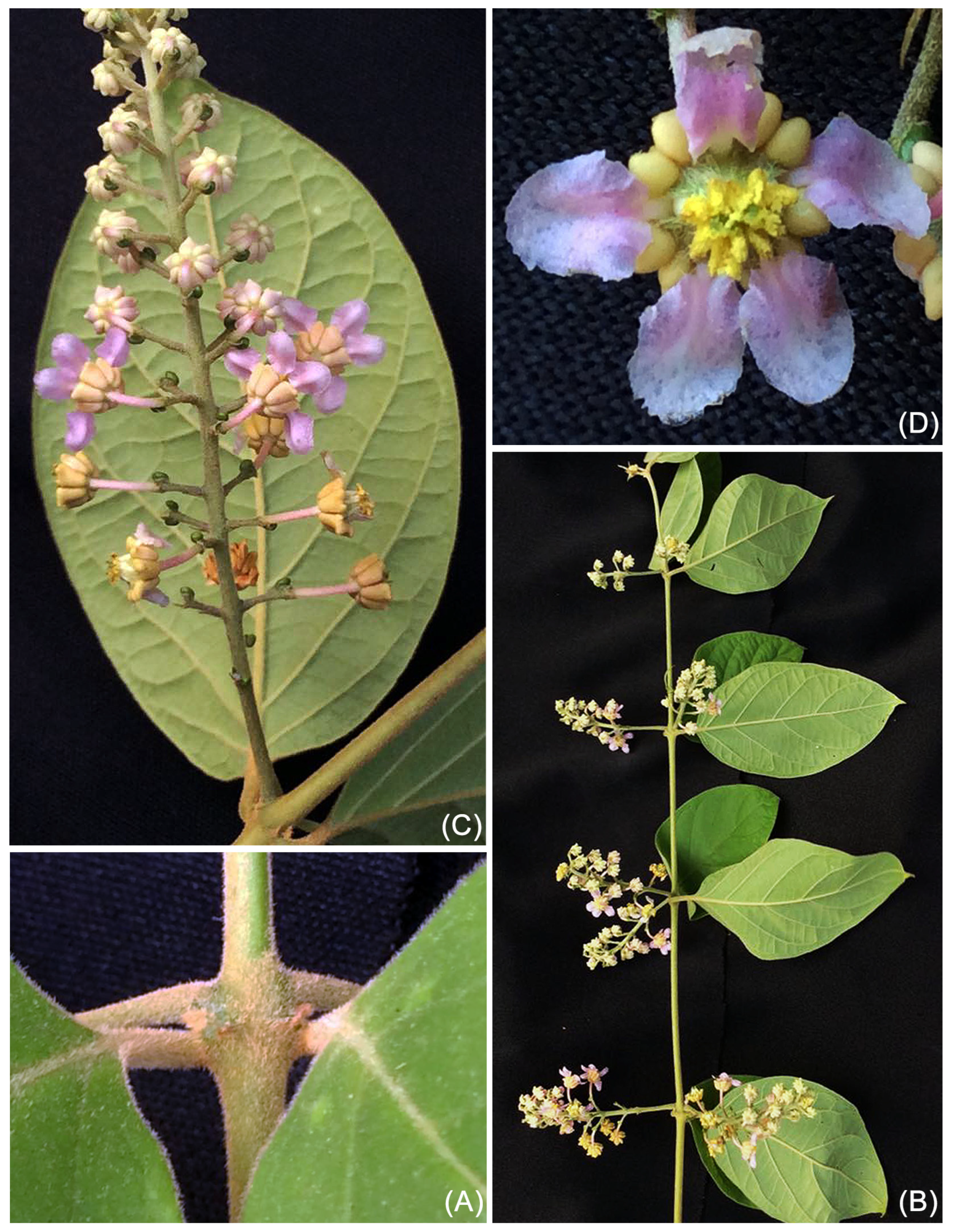

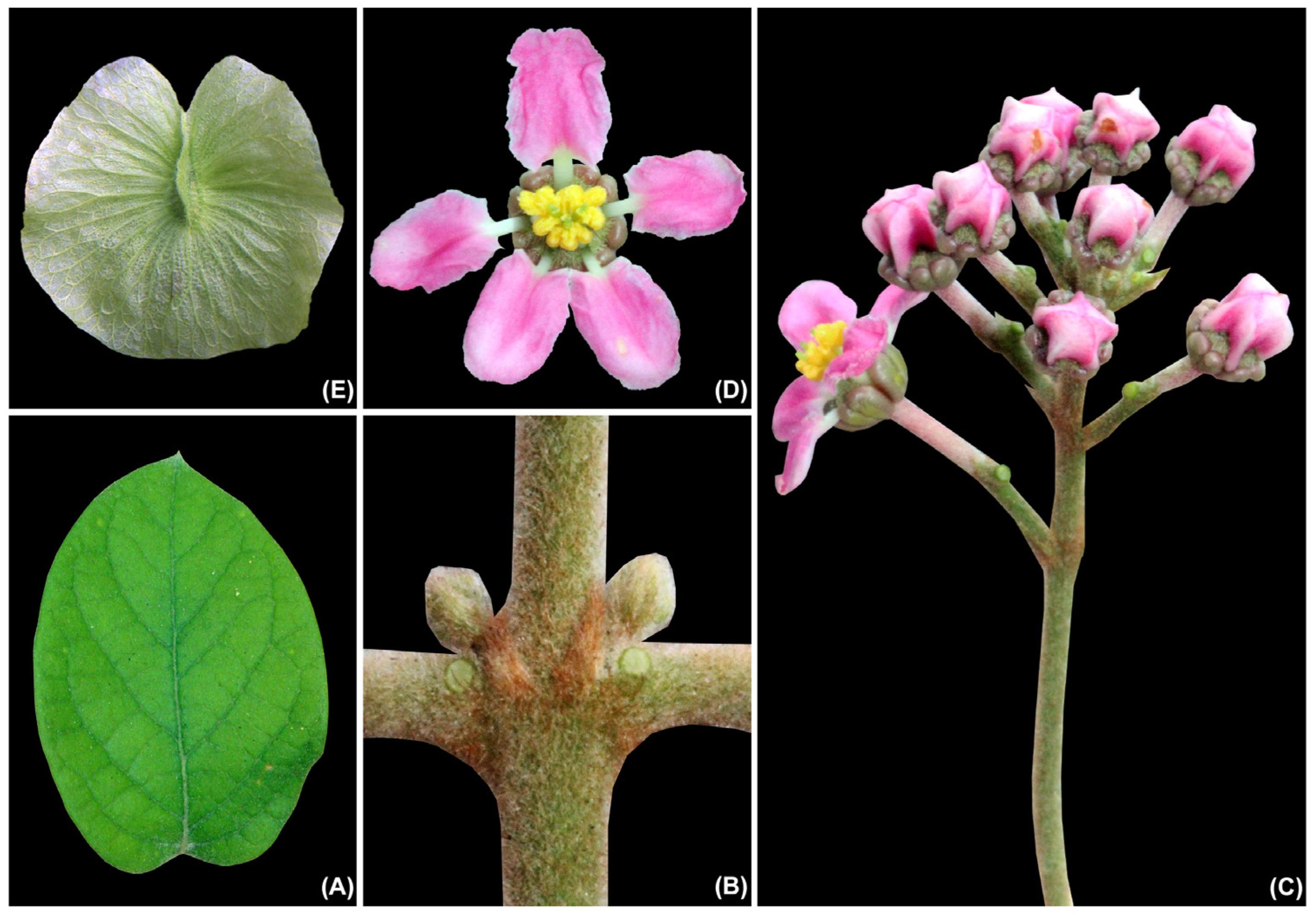
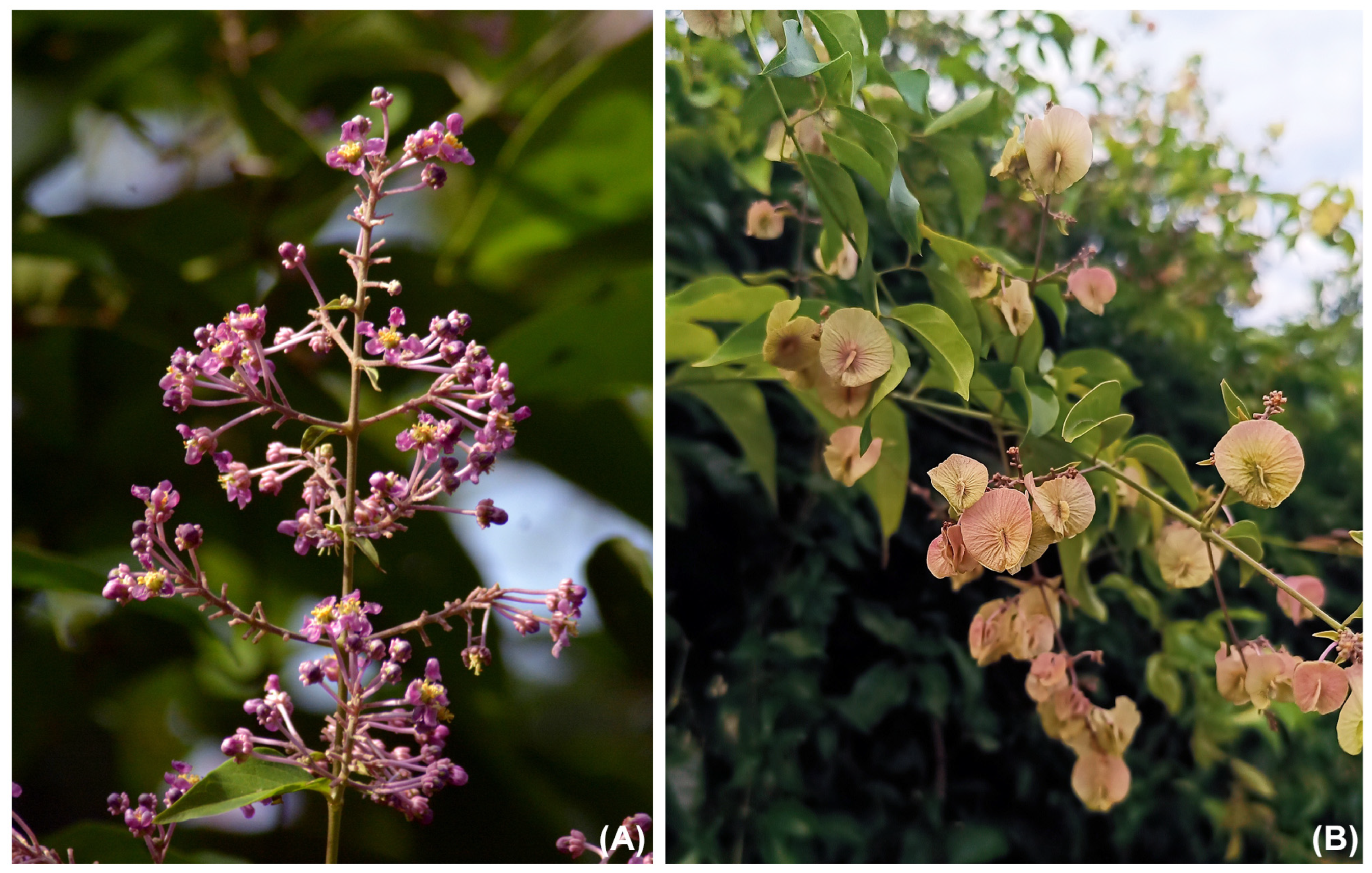
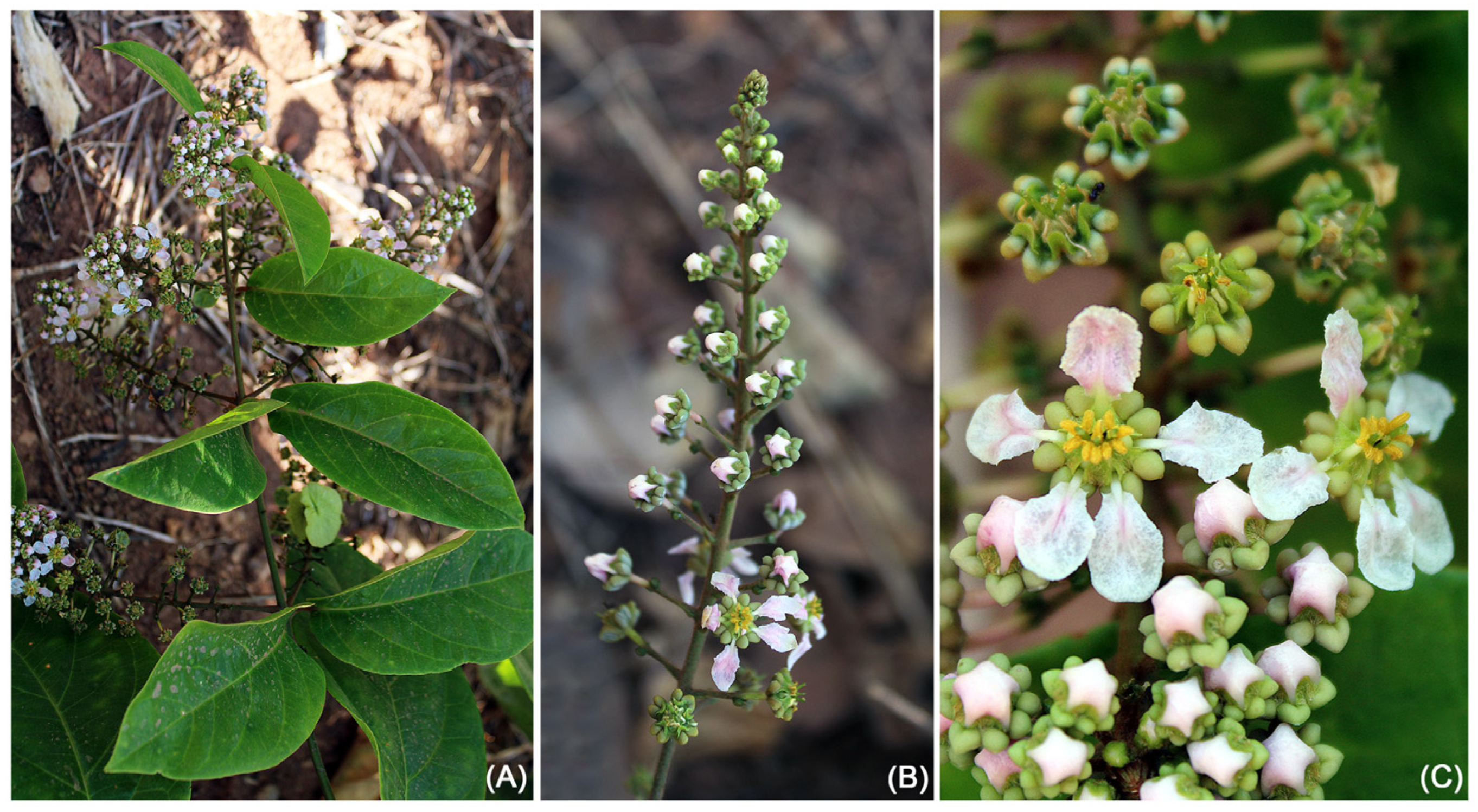
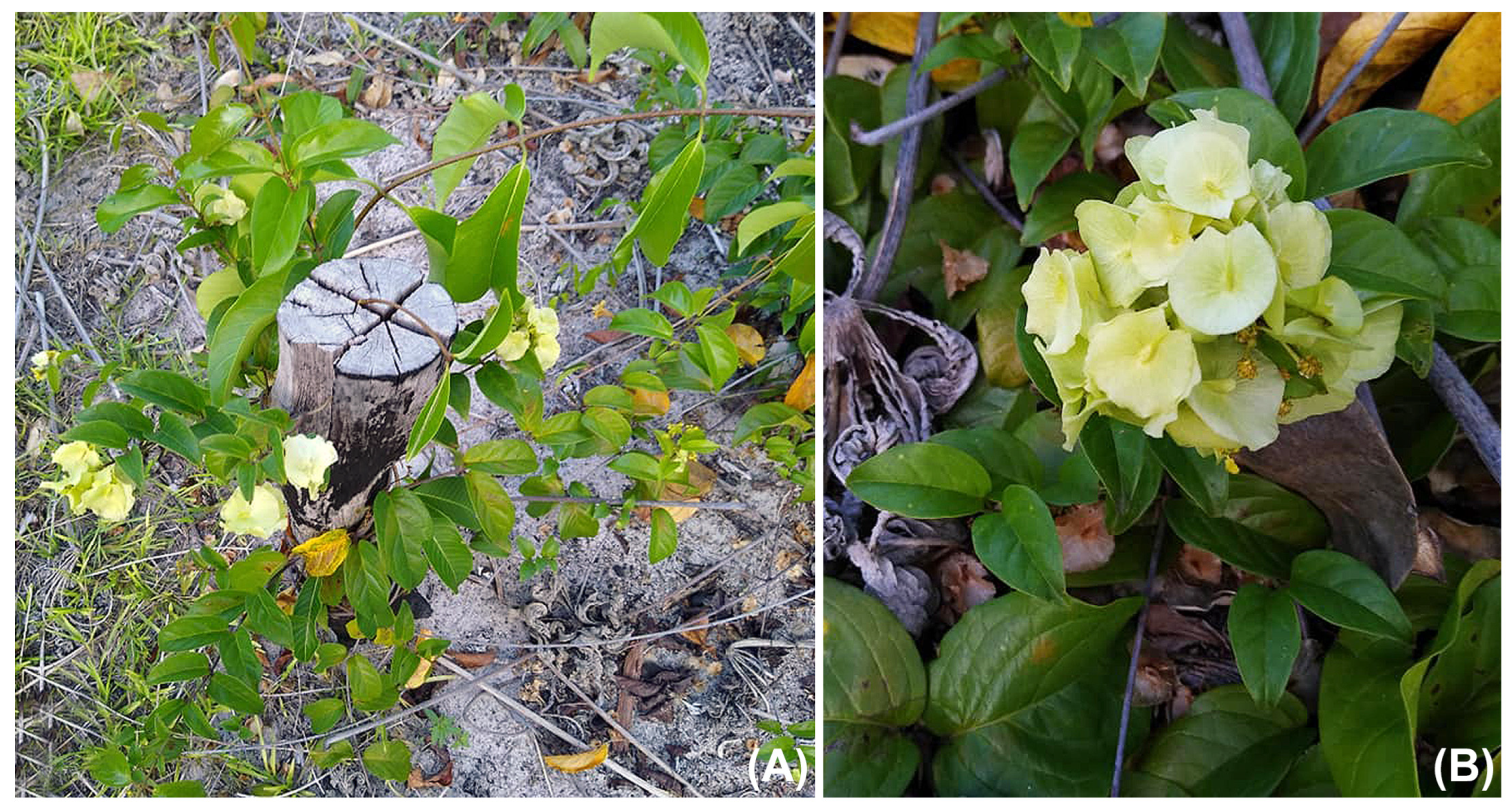
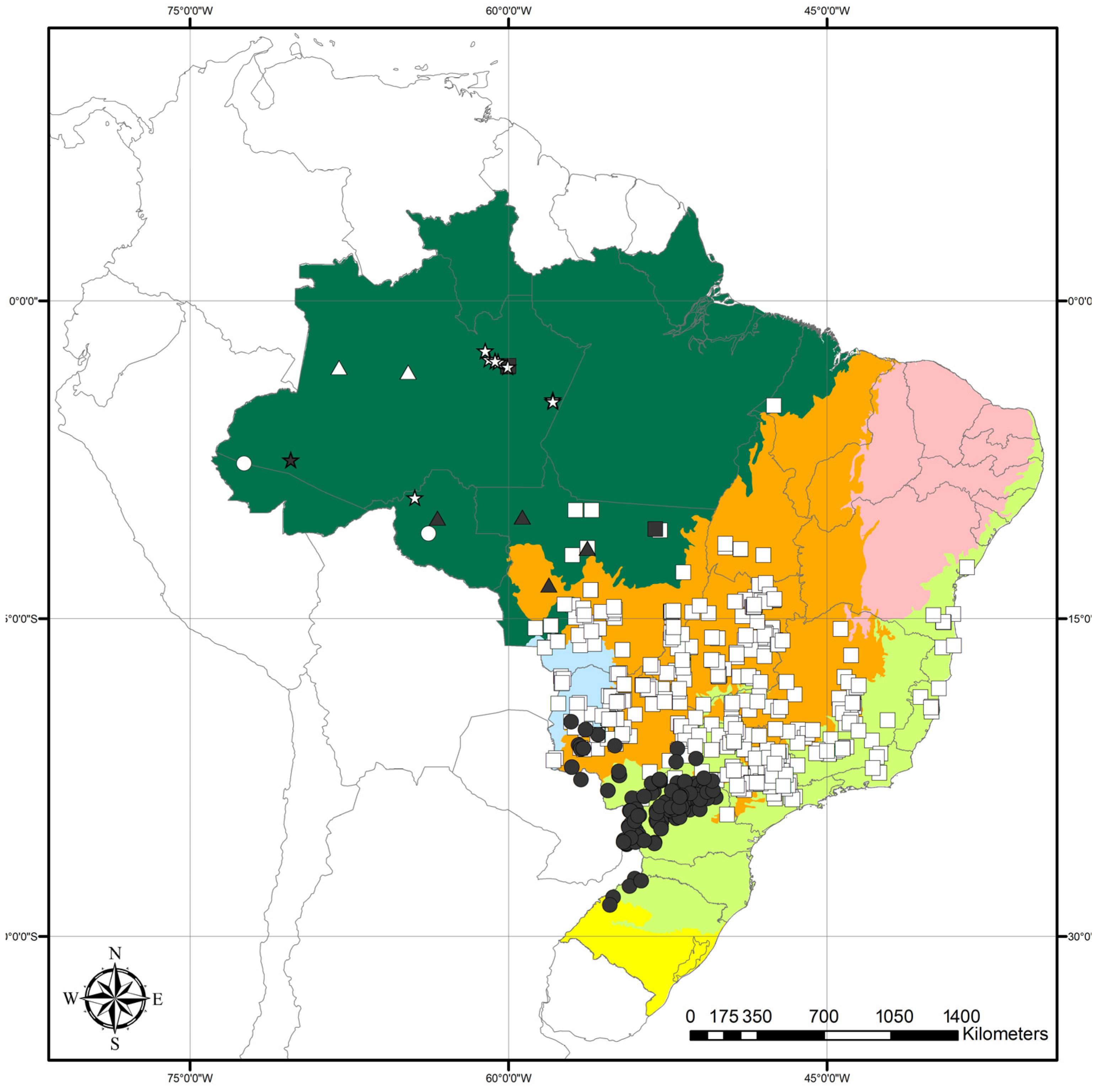
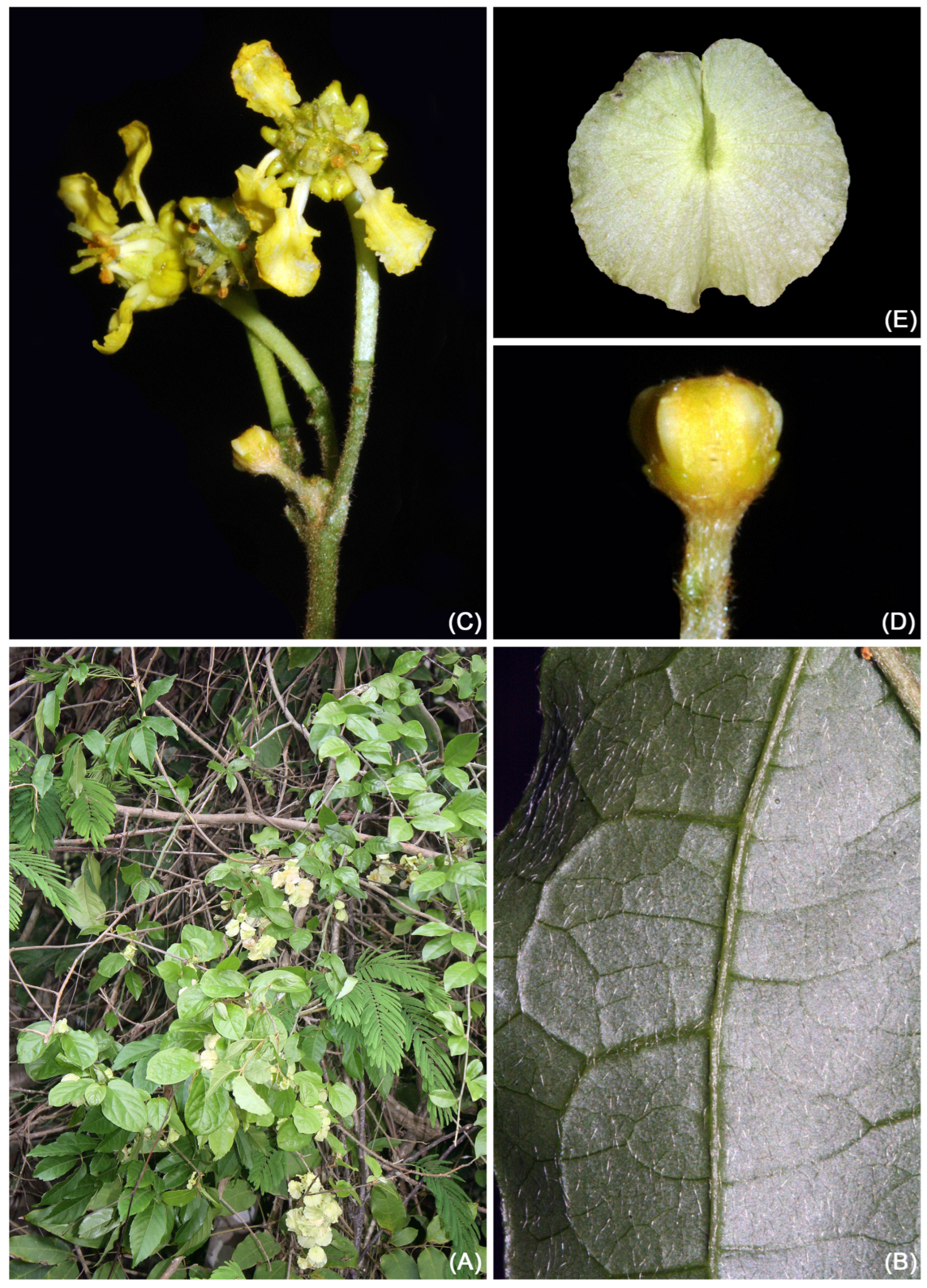

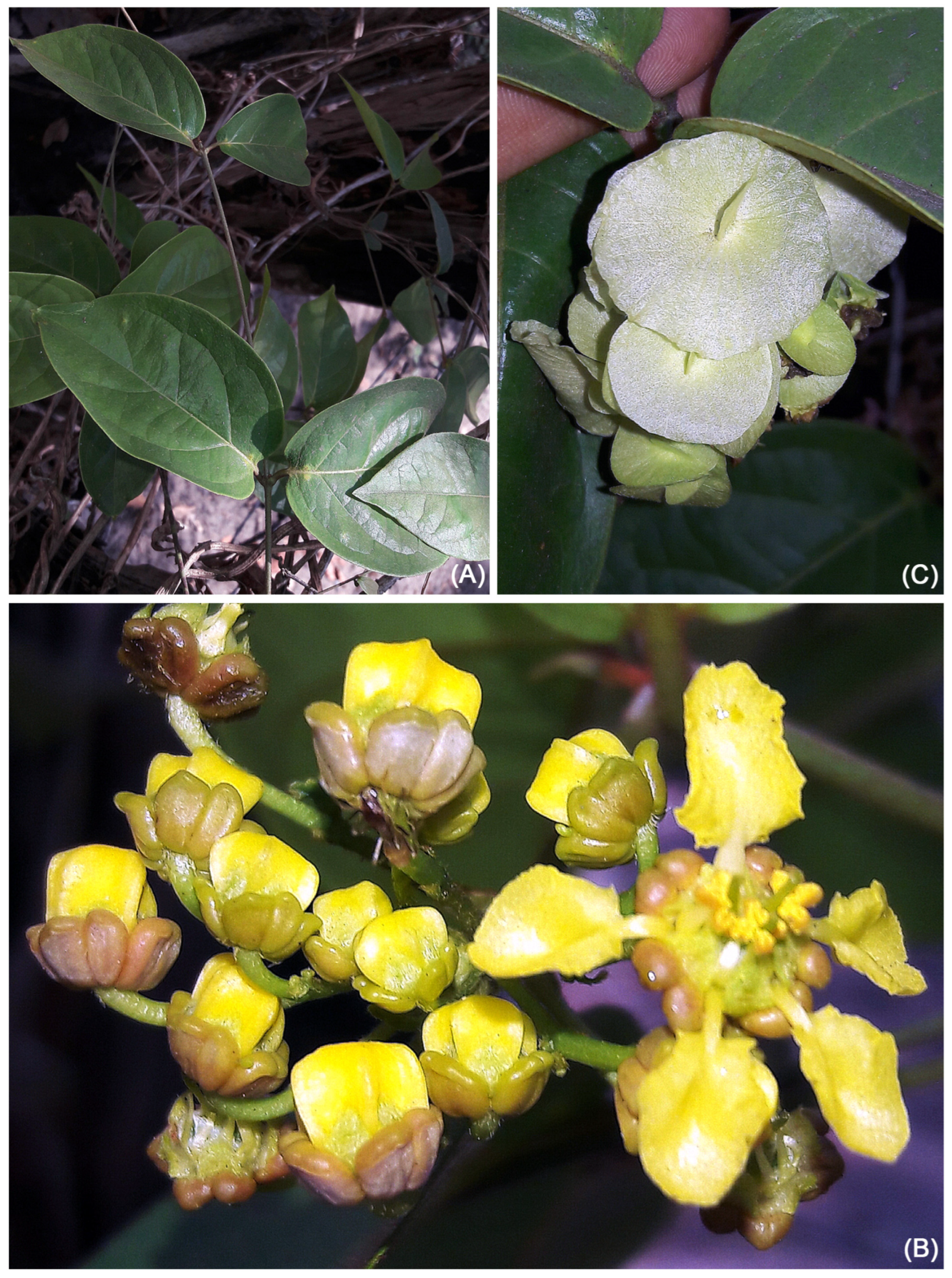
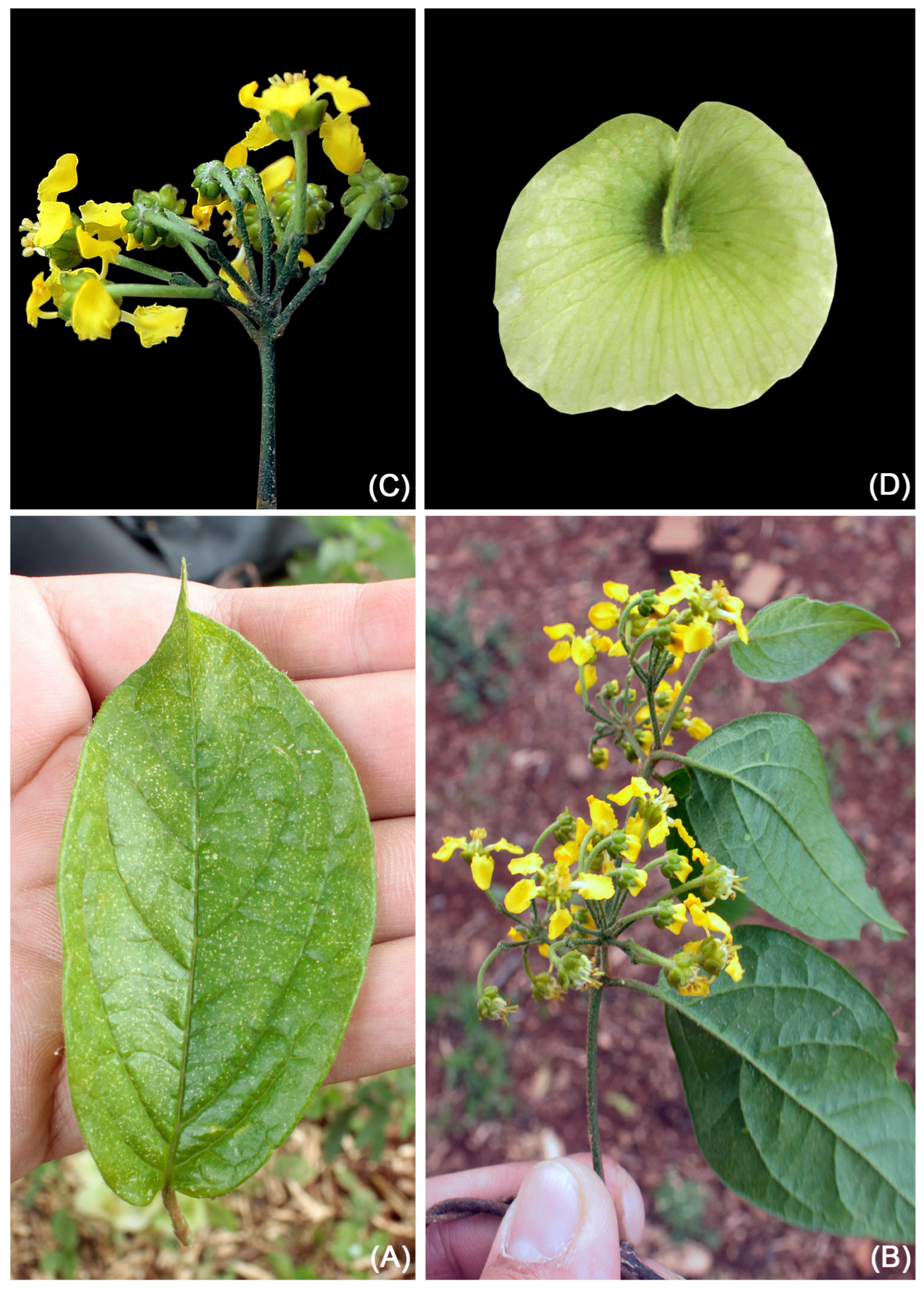
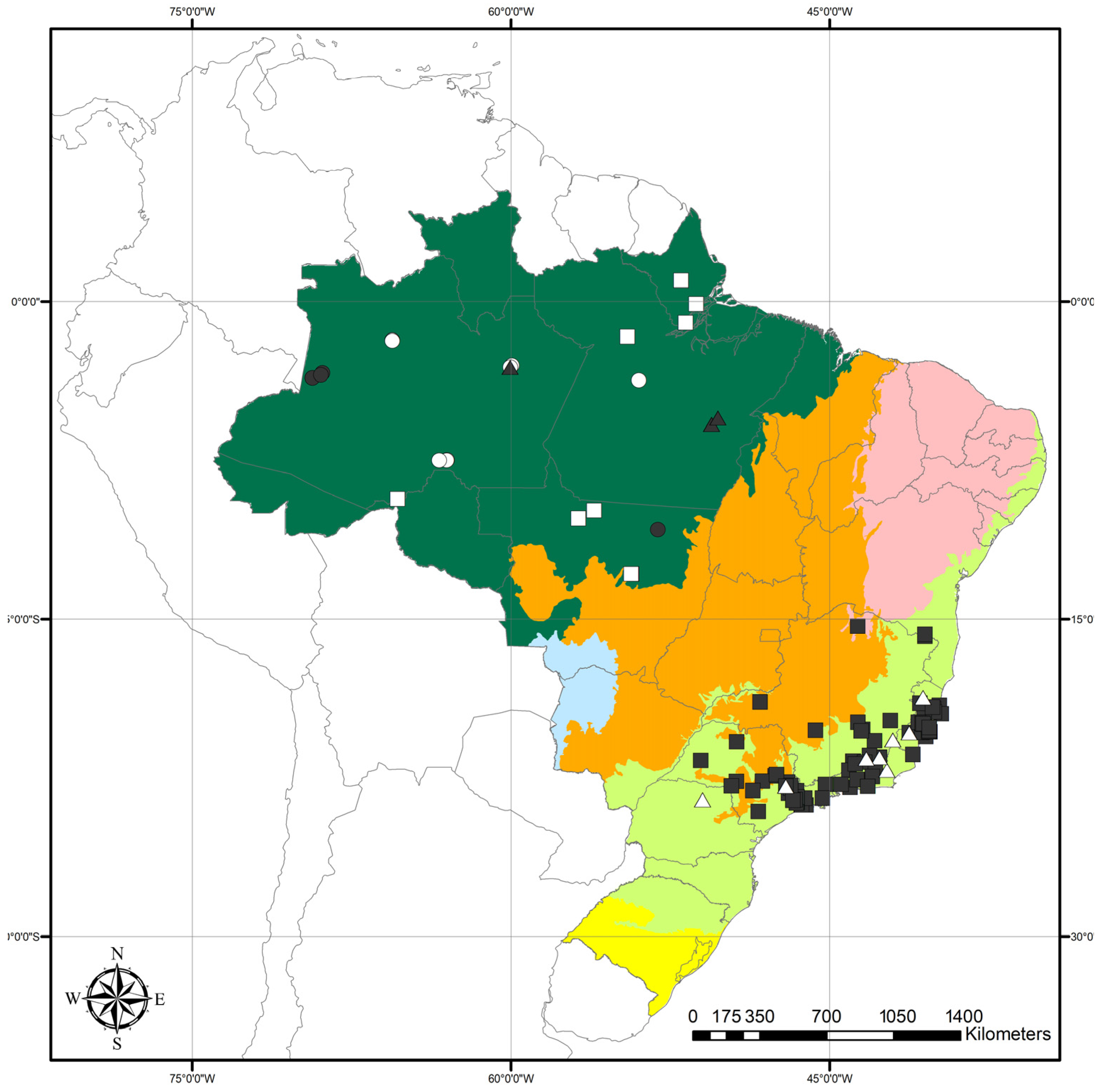
Disclaimer/Publisher’s Note: The statements, opinions and data contained in all publications are solely those of the individual author(s) and contributor(s) and not of MDPI and/or the editor(s). MDPI and/or the editor(s) disclaim responsibility for any injury to people or property resulting from any ideas, methods, instructions or products referred to in the content. |
© 2025 by the authors. Licensee MDPI, Basel, Switzerland. This article is an open access article distributed under the terms and conditions of the Creative Commons Attribution (CC BY) license (https://creativecommons.org/licenses/by/4.0/).
Share and Cite
Almeida, R.F.d.; Pellegrini, M.O.d.O. Taxonomic Synopsis of Mascagnia (Malpighiaceae) of Brazil. Taxonomy 2025, 5, 50. https://doi.org/10.3390/taxonomy5030050
Almeida RFd, Pellegrini MOdO. Taxonomic Synopsis of Mascagnia (Malpighiaceae) of Brazil. Taxonomy. 2025; 5(3):50. https://doi.org/10.3390/taxonomy5030050
Chicago/Turabian StyleAlmeida, Rafael Felipe de, and Marco Octavio de Oliveira Pellegrini. 2025. "Taxonomic Synopsis of Mascagnia (Malpighiaceae) of Brazil" Taxonomy 5, no. 3: 50. https://doi.org/10.3390/taxonomy5030050
APA StyleAlmeida, R. F. d., & Pellegrini, M. O. d. O. (2025). Taxonomic Synopsis of Mascagnia (Malpighiaceae) of Brazil. Taxonomy, 5(3), 50. https://doi.org/10.3390/taxonomy5030050






